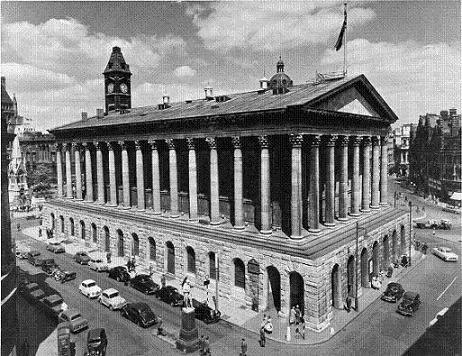Birmingham Town Hall is one of the oldest concert halls in the world. Funded by public subscription it was opened in 1834. Designed by Joseph Hansom (of 'Hansom' Cab fame) and John Welch, it is thought to be modelled on the Temple of Castor and Pollux in Rome. The Town Hall is built in brick and faced with marble which was quarried in north Wales and shipped 80 miles by sea and 100 miles by canal to Birmingham. The cost of excavating and transporting the stone led to Hansom becoming bankrupt.
The Town Hall was closed in 1996, partly over concerns for the perishing marble. A major programme of restoration was undertaken and the Town Hall re-opened in 2007.
The stone with which the Town Hall was built is popularly known as Anglesey Marble and is white carboniferous limestone. This stone is characterised by its bright white colour, fine natural fissures (splits) and natural impurities such as iron and salts. It is these fissures and splits which led to the deterioration of the stonework and the need for repair.
The master stonemasons found that Anglesey stone in particular is extremely difficult to carve and work. It is so hard that the most up to date tungsten carbide chisels were being split by the stone as they worked it. As a consequence, most of the new carving has been completed using angle grinders. The masons are mystified as to how their counterparts in 1834 carved the original stone!
Investigatory work has found that there are fossils present in it, some of which are as large as the palm of your hand. If you look around the building, you will find fossils in the blocks.
The masons also found shards of mother of pearl (flat oyster shells) in the stone joints, which were used as spacers to keep the stones apart and level prior to the joints being pointed with lime mortar. This is not as strange as it would seem, as in the early 19th century, oysters were a staple food for everyday people.
It was always said that Birmingham Town Hall was built on pearl, but until recently the basis for this was not known. Recent discovery has shown that shell was used between stones to balance them and, more importantly, pearl dust was used to make the mortar. It was very strong, and the building’s foundations extend down 15 feet. Unlike other dust, pearl presented no health problems and indeed was beneficial in healing cuts.

Claimed by the buildings' architects to “become whiter with age and (be) imperishable by time”, the industrial environment of central Birmingham took its toll: photographs taken prior to the cleaning of the external stonework in 1982 show the building to have been of a sooty hue.
Your tasks
To log this cache, you will need to complete the tasks below. You can use information from the cache page and your observations at GZ to do this. Please message us with the info (rather than post it on your log). You can log a find once we have been sent a message; there is no need to wait for a reply. We may delete your log if your answer is way off the mark.
- Go to the building (any side is fine) and examine the exterior stonework. Describe what you see (texture, colour, fossils etc). What evidence of repair / restoration can you see?
- The repair programme was necessary because the stone had deteriorated. Explain how the nature of the stone and other environmental factors led to this deterioration. Why do you think that the deterioration was worse on the more ornate blocks?
- Look up at the columns. Estimate how many pieces of stone are in each column. Why do you think so many pieces were needed?
- As an optional extra, post a picture of yourself and / or your GPSr at the Town Hall.